First
Alert
USER'S
MANUAL
10
YEAR
SEALED
BATTERY
OPERATED
CARBON
MONOXIDE
ALARM
WITH
DIGITAL
DISPLAY
AND
SILENCE
FEATURE
CONFORMS
TO
UL2034
STANDARD
Model
C01210
IMPORTANT!
PLEASE
READ
CAREFULLY
AND
SAVE.
This
user's
manual
contains
important information
about
your
Carbon
Monoxide (CO)Alarm's operation. Ifyou are installing this CO Alarm for
use
by
others,
you
must
leave
this
manual—or
a
copy
of it—with
the
end
user.
M08-0483-001
P
03/14
Printed
in
Mexico
TABLE
OF
CONTENTS
Introduction
1-2
Basic
Safety
Information 1
How
Your
CO
Alarm
Works
1
Understanding Your CO Alarm 2
Using the
Peak
CO Memory 2
Installation
.2-3
Where
to
Install
CO
Alarms
2
Where
CO
Alarms
Should
NOT
Be
Installed
2
How
to
Install
Your
CO
Alarm
3
If
Your
CO
Alanti
Sounds
3
If
the
Alarm Signal
Sounds
3
Using
the
Silence Feature 3
To
Permanently
Deactivate
the
CO
Alarm
3
Testing
and
Maintenance
.4
Weekly Testing 4
Regular
Maintenance
4
What
You
Need
To
Know
About
CO
.4
What
is
CO?
4
Symptoms of CO Poisoning 4
Finding
the
Source
of QO After an Alarm 4
How Can I Protect My Family? 4
Potential
Sources
of
CO
in
the
Home
.5-6
Underwriters
Laboratories
Inc.
UL2034
5-6
General
Limitations
Of
CO
Alarms
5-6
Troubleshooting
Guide
5-6
Limited
Warranty
5-6
© 2014-BRK Brands, Inc. Allrights reserved. Distributed by BRKBrands, Inc.
3901
Liberty
Street
Road,
Aurora,
IL
60504-8122
Consumer
Affairs: (800) 323-9005
www.brkelectronics.com
•
www.firstalert.com
INTRODUCTION
BASIC
SAFETY
INFORMATION
IMPORTANT!
• Dangers, Warnings, and Cautions alert you to important operating
instructions or
to
potentially
hazardous
situations. Pay special
attention
to
these
items.
• THIS IS NOT A
SMOKE
ALARM!
This
CO Alarm is
designed
to
detect
carbon
monoxide
from
ANY
source
of
combustion.
It is NOT
designed
to
detect
smoke,
fire,
or
any
other
gas.
ACAUTION!
• This CO Alarm will
only
indicate
the
presence
of
carbon
monoxide
gas
at
the
sensor.
Carbon
monoxide
gas
may
be
present
in
other
areas.
AWARNING!
• NEVER
ignore
your
Carbon
Monoxide
Alarm
if it
alarms.
Refer
to
"If
Your
CO
Alarm
Sounds"
for
more
information.
Failure
to
do
so
can
result
in
injury
or
death.
•
Test
the
CO
Alarm
once
a
week.
If
the
CO
Alarm
ever
fails
to
test
correctly,
have
it
replaced
immediately!
If
the
CO
Alarm
is
not
working
properly, it
cannot
alert
you
to
a
problem.
•
This
product
is
intended
for
use
in ordinary
indoor
locations
of
family
living
units.
It is
not
designed
to
measure
CO
levels
in
compliance
with
Occupational
Safety
and
Health Administration (OSHA)
commer
cial
or
industrial
standards.
Individuals
with
medical
conditions
that
may
make
them
more
sensitive
to
carbon
monoxide
may
consider
using
warning
devices
which
provide
audible
and
visual
signals
for
carbon
monoxide
concentrations
under
30
ppm.
For
additional
infor
mation
on
carbon
monoxide
and
your
medical
condition
contact
your
physician.
FCC
Compliance
This equipment
has
been
tested
and
found to comply with
the
limits for a
Class
B digital device,
pursuant
to Part 15 of
the
FCC rules.
These
limits are
designed
to provide
reasonable
protection against harmful interference in
a residential installation. This equipment
generates,
uses
and
can
radiate
radio frequency energy and, if not installed
and
used
in
accordance
with
the
instructions,
may
cause
harmful
interference
to
radio
communications.
However,
there
is
no
guarantee
that
the
interference
will
not
occur
in a
particular installation. Ifthis
equipment
does
cause
harmful interference to
radio or television reception, which
can
be determined by turning
the
equip
ment off
and
on,
the
user
is
encouraged
to try to correct the interference by
one
or
more
of
the
following
measures:
• Reorient or
relocate
the
receiving
antenna.
•
Increase
the
separation
between
the
equipment
and
receiver.
e
Connect
the
equipment
into an outlet on a circuit different from
that
of
the
receiver.
• Consult
the
dealer
or an experienced radio or TVtechnician for help.
Warning:
Changes
or modifications to
the
product, not expressly approved
by First Alert / BRK
Brands,
Inc.,
could
void
the
user's
authority to
operate
the
equipment.
This
device
complies with Part 15 of
the
FCC Rules. Operation is
subject
to
the
following
two
conditions: (1)this
device
may not
cause
harmful
interference,
and
(2)
this
device
must
accept
any
interference received,
including interference
that
may
cause
undesired operation.
HOW
YOUR
CO
ALARM
WORKS
GENERAL
INFORMATION
AWARNING!
• CO
Alarm
contains
a
sealed,
non-replaceable
battery.
Once
it
reaches
the
end
of
its
service
life, or
after
10
years—whichever
comes
first—
you
must
install a
new
CO
Alarm,
• High
temperatures,
low
temperatures,
high
humidity,
impact
or
dropping
can
adversely
affect
LCD
displays.
A
CO
Alarm
measures
the
CO
levels
in
the
air. It will
alarm
if
CO
levels
rise
quickly (if
the
heat
exchanger
on
your
furnace
breaks, for example), or if CO
is consistently
present
(a slow CO leak on a fuel-burning appliance).
This
carbon
monoxide alarm features a permanently installed sensor, two
colored indicator lights,
and
an 85 dB alarm horn. It
also
has
a silence feature
to temporarily
quiet
the
alarm
horn.
THE
PARTS
OF
YOUR
CO
ALARM
1 Activation
Switch
(in back)
2
Test
Button
3
Silence
Button
4
POWER/ALARM
Light (Green/Red)
2,
3,
& 6
5 (Behind Cover) Alarm Horn:
85dB
audible
alarm
for
test,
alarm,
and
unit malfunction warning.
6
Peak
Level
Button
7 Digital Display
UNDERSTANDING
YOUR
CO
ALARM
Lights blink and horn chirps when Alarm is first
activated.
DIGITAL
DISPLAY:
All
segments
are turned on for a
short
time
upon
initial power.
Then
the
temperature
is
displayed.
ALARM
RECEIVING
BATTERY
POWER
Green light
flashes
every minute. Horn is silent.
Temperature
will
be
displayed.
DURING
TESTING
Light flashes Red in
sync
with
the
horn pattern (4
beeps,
pause, 4 beeps),
simulating a CO Alarm condition.
DIGITAL
DISPLAY:
During the
simulated
CO alarm, "CO" is
displayed along with a full alarm
level.
Several
ppmCO
levels
are
also
displayed
and the
alarm
level
isshown
increasing.
CO
ALARM
Sensor
has
detected
enough
CO to trigger an alarm. Light flashes rapidly
and horn
sounds
loudly (repeating 4 beeps, pause).
See
"IfYourCO Alarm
Sounds"
for details. During
an
alarm,
move
everyone
to
a
source
of
fresh
air.
DO
NOT
move
the
CO
Alarm!
DIGITAL
DISPLAY:
"00"
alternating with
the ppm number,a fulllevel,and
"EVACUATE".
CO
ALARM
REQUIRES SERVICE (MALFUNCTION SIGNAL)
The light flashes (GREEN)and
the
horn
sounds
3 "chirps" every minute. CO Alarm
needs
to
be
replaced.
DIGITALDISPLAY:"Err" is
displayed.
CO
ALARM
END
OF
LIFE
The LED
flashes
Green
5
times
in
sync
with 5
chirps
every minute. CO Alarm
needs
to be replaced.
DIGITAL
DISPLAY:
"End" is displayed.
UVEl
KEMQRV
Leva
UVEL
wrn
™
il_J
in™
WL.U
w
IU
EVACUATE
USING
THE
PEAK
CO
MEMORY
The
CO Memory
Feature
lets
you
check
the
highest
level of CO
recorded
during an alarm.
To
check
CO
Memory:
1.
Press
the
Peak
Level Button until
the
peak
CO
level is
displayed.
To
clear
CO
Memory:
1. Automatically
resets
after 24 hours.
2a. While
checking
CO memory,
press
or hold
the
Peak
Level
Button
until "CLEAR" is displayed,
b.
Press
or
hold
the
Peak
Level
Button
until
the
CO
Memoryls
cleared.
NOTE:
The
highest
CO level will
be
saved
for 24
hours.
DO NOT
clear
the
CO Memory reading if you plan to call
someone
to investigate a CO problem!
Clear
the
CO Memory reading only after
the
investigator
has
checked
your
home. Ifthe investigator willnot arrive within
the
24 hour time period before
the
unit automatically
resets,
be
sure
to write
down
the
peak
level.
INSTALLATION
WHERE
TO
INSTALL
CO
ALARMS
The
National Fire
Protection
Association
(NFPA)
recommends
that
a CO Alarm
should
be
centrally
located
outside
of
each
separate
sleeping
area
in
the
immediate vicinity of
the
bedrooms.
For
added
protection, install additional
CO Alarms in
each
separate
bedroom,
and
on
every
level of your
home.
Ifyour bedroom hallway is longer
than
40 feet (12 meters), install a CO Alarm
at BOTH
ends
of
the
hallway.
♦
BEDROOM
Y.
M
h-
HAL
LIVING
ROOM
X
HALL
ft
[*/"*•
BEDROOM
0
♦
BEDROOM
<^>
REQUIRED
TO
MEET
NFPA
RECOMMENDATIONS
^
SUGGESTED
AREAS
FOR
INSTALLING
ADDITIONAL
CO
ALARMS
In a
Single-level
Home:
• Install at
least
one
CO Alarm
near
or within
each
separate
sleeping
area.
• For
added
protection, install an additional CO Alarm at least 20 feet
(6 meters)
away
from the furnace or fuel burning
heat
source.
In a
Multi-level
Home:
• Install
at
least
one
CO Alarm
near
or within
each
separate
sleeping
area.
• For
added
protection, install
at
least
one
CO Alarm on
each
level of
the
home.
Ifyou
have
a
basement,
install
that
CO Alarm at
the
top
of
the
basement
stairs.
• For
added
protection, install an additional CO Alarm at least 20 feet
(6
meters)
away
from
the
furnace
or fuel burning
heat
source.
In a
Mobile
Home:
•
Install
CO
Alarms
on
inside
walls
ONLY.
Uninsulated
outside
walls
and
roofs
of
mobile
homes
often
transfer
heat
and
cold
from
outdoors.
WHERE
CO
ALARMS
SHOULD
NOT
BE
INSTALLED
DO
NOT
install
this
CO
Alarm:
• In garages, kitchens, furnace rooms, or in any extremely dusty, dirty or
• Closer
than
20 feet (6 meters) from a furnace or
other
fuel burning
heat
source, or fuel burning appliances like a
water
heater.
• Within 5 feet (1.5 meters) of any cooking appliance.
• In extremely humid areas. This alarm should be at least 10 feet (3 meters)
from a
bath
or shower,
sauna,
humidifier, vaporizer, dishwasher, laundry
room, utility room or other
source
of high humidity.
• In areas where temperature is colder than 40°F (4.4°C) or hotter than
100° F (37.8°C). These
areas
include unconditioned crawl
spaces,
unfinished attics, uninsulated or poorly insulated ceilings,
porches,
and
garages.
• Inturbulent air, like near ceiling fans, heat vents, air conditioners, fresh air
returns, or
open
windows. Blowing air may prevent CO from reaching the
sensors.
• In direct sunlight.
AWARNING!
•
This
CO
Alarm
is
designed
for
use
inside
a
single-family
home
or
apartment
It is
not
meant
to
be
used
in
common
lobbies,
hallways,
or
basements
of
multi-family
buildings
unless
working
CO
Alarms
are
also
installed in
each
family living unit. CO
Alarms
in
common
areas
may
not
be
heard
from
inside
individual family living
units.
•
This
CO
Alarm
alone
is
not
a
suitable
substitute
for
complete
detection
systems
in
places
which
house
many
people,
like
hotels
or
dormitories,
unless
a CO
Alarm
is
also
placed
in
each
unit
• DO
NOT
use
this
CO
Alarm
in
warehouses,
industrial
or
commercial
buildings,
special-purpose
non-residential
buildings,
RVs,
boats,
or
airplanes.
This
CO
Alarm
is
specifically
designed
for residential
use,
and
may
not
provide
adequate
protection
in
non-residential
applications.
,'
2
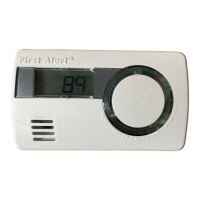








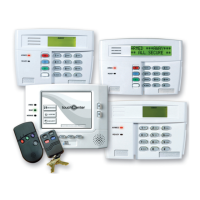
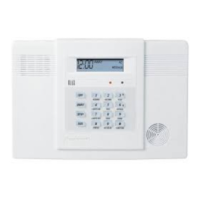
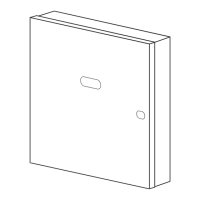
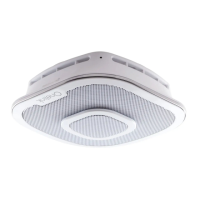
